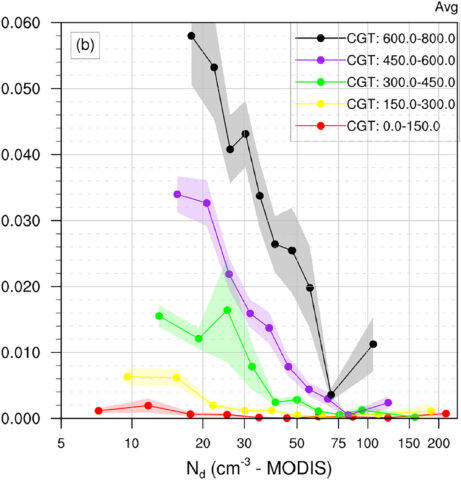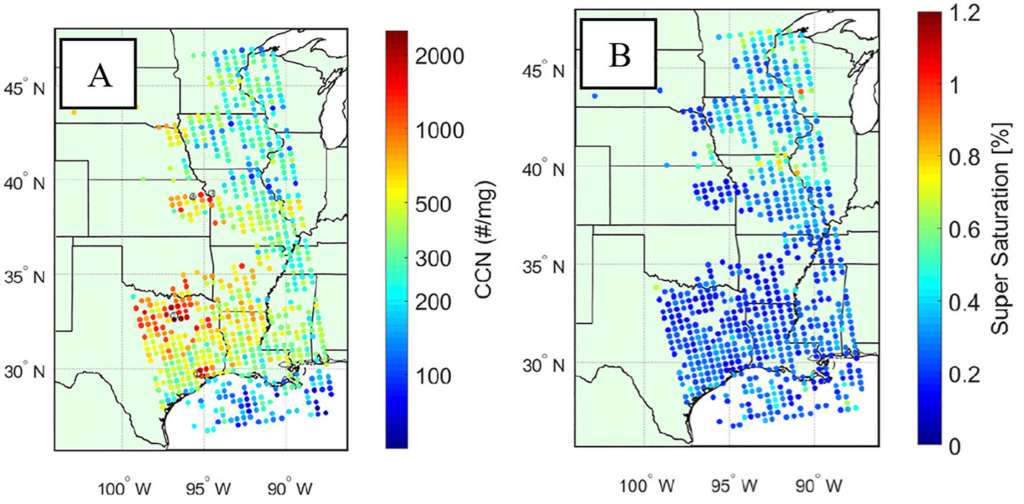Editors’ Vox is a blog from AGU’s Publications Department.
Aerosols are small airborne liquid or solid particles, originating from natural sources such as dust, sea spray, and biological particles, or anthropogenic sources such as smoke and other particulate emissions. These particles serve as the basis for the formation of clouds, and thus have a significant impact on Earth’s climate and energy budget.
A new article in Reviews of Geophysics explores the ways that scientists study aerosols and their effects from space. We asked the authors to give an overview of aerosols, how satellites are used to study them, and what challenges remain.
Why are aerosols important to understand?
Aerosols absorb and reflect solar radiation directly which affects Earth’s energy budget. Anthropogenic aerosols thus directly exert a radiative forcing that affects the global temperature. Additionally, aerosols can alter cloud composition and hence their structure, life cycle, and precipitation properties. These changes imply radiative perturbations, also known as indirect effects of aerosols, whose impacts on Earth’s energy budget and global temperature are even greater than the direct effect. Furthermore, the impacts on the hydrological cycles have large consequences concerning the weather and climate system beyond the global temperature.
What are some of the ways that aerosols impact clouds?

Cloud drops must condense on pre-existing aerosol particles that have some soluble content. Therefore, clouds polluted by many aerosol particles contain more droplets. This makes clouds reflect more solar radiation to space, thus having an increased cooling effect. Additionally, when more numerous, cloud droplets are smaller and therefore slower to coalesce into rain, as demonstrated in Figure 1.
The aerosol-induced rain suppression prolongs clouds’ lifetime and coverage, further enhancing the radiative cooling. In turn, smaller droplets also evaporate faster. Suppression of rain in deep convective clouds allows more water to be lifted above the freezing level, where it freezes into ice precipitation in a process that creates lightning. Polluted clouds are often observed to be deeper and larger. Certain dust and biological aerosols are required for initiating the ice phase in the clouds at temperatures higher than -38 °C.
How do anthropogenic aerosols impact the Earth’s climate?
The anthropogenic aerosols increase the albedo and coverage of low water clouds. The resultant negative radiative forcing currently offsets about a third of the greenhouse positive (i.e. warming) radiative forcing. The magnitude of this estimate has a large uncertainty, which dominates the overall estimate of the anthropogenic radiative forcing.
In addition to an impact on the global average temperature, the global distribution of the cooling affects global temperature gradients and circulation systems. For example, the greater anthropogenic aerosol emissions in the northern hemisphere shifted the thermal equator southward, along with the intertropical convergence zone and monsoonal rain patterns. While the aerosols may have substantial effects on deep convective clouds, the radiative impacts on Earth’s energy budget from these clouds are less clear and remain a major challenge.
How do scientists study aerosols and their effects?
Aerosol effects span from the molecular to global scales and respectively require a range of approaches. The aerosol formation and activation of cloud droplets are studied mainly in physical chemistry laboratories and cloud chambers. The aerosol effects on specific cloud processes are studied by specially instrumented airplanes that measure the aerosols and cloud compositions.
Satellites can be used for retrieving both the aerosol and cloud properties required for understanding the processes by which aerosols affect clouds.
The long-term measurement of the system at a global scale requires satellite observations. Satellites are especially suitable for measuring the aerosol-cloud-mediated radiative effects because they can directly measure the radiation that is reflected and emitted from the clouds and their surroundings. Satellites can be used for retrieving both the aerosol and cloud properties required for understanding the processes by which aerosols affect clouds. This includes aerosol optical depth and sizes, cloud droplet size and concentration, cloud liquid water path, precipitation rate, cloud patterns and heights. All these observations are used to develop and constrain cloud-resolving simulations aimed at understanding specific mechanisms, and global simulations which can be used to assess the effects on climate.
What are the biggest challenges with using satellites to observe aerosol forcing?
Retrieving the concentrations of aerosols that can nucleate cloud droplets from satellite measurements is a major challenge, which worsens in clean conditions where the optical signal to be measured is small. The effect of the aerosols on the clouds is proportional to the fractional change in the aerosol concentrations until the effects saturate in very polluted conditions. Therefore, a small absolute change in aerosols in very clean conditions that is indiscernible by the satellite is a large fractional change with a respective large impact on clouds. An example of satellite-retrieved concentrations of cloud-drop-producing aerosols is given in Figure 2.

A related major challenge is the lack of knowledge of the background pristine environment that would have occurred without anthropogenic emissions. Aerosols are important mostly because they nucleate cloud droplets and determine their concentrations. But retrieving cloud drop concentrations is subjected to many challenges due to inhomogeneity, the 3-dimensional structure of the clouds, and their dilution by mixing with the environment.
What additional research, data, or modeling are needed to overcome these challenges?
New planned satellite missions, particularly with multi-angle polarimetric measurements, will improve the retrievals of aerosols and cloud drop concentrations.
New planned satellite missions, particularly with multi-angle polarimetric measurements, will improve the retrievals of aerosols and cloud drop concentrations. A better quantitative understanding of the pre-industrial aerosol background is also necessary for quantifying the radiative forcing. The susceptibility of cloud properties to aerosols is highly dependent on cloud regimes, which have to be determined by cloud-controlling factors that do not depend on aerosols and are defined identically in the observations and the application to global models.
Although aerosol effects on clouds can be simulated reasonably well at high resolution, the cloud representation in global models suffers greatly due to computational limitations of the resolution. This coarse resolution implies that the aerosol effects on clouds have to be incorporated in their parameterization. A great improvement will come with the advent of additional computational power that will allow running global models at a cloud-resolving resolution.
—Daniel Rosenfeld ([email protected]; ![]() 0000-0002-0784-7656), The Hebrew University of Jerusalem, Israel; Alexander Kokhanovsky (
0000-0002-0784-7656), The Hebrew University of Jerusalem, Israel; Alexander Kokhanovsky (![]() 0000-0001-7110-223X), German Research Centre for Geosciences, Germany; Tom Goren (
0000-0001-7110-223X), German Research Centre for Geosciences, Germany; Tom Goren (![]() 0000-0001-5618-9402), Bar-Ilan University, Israel; Edward Gryspeerdt (
0000-0001-5618-9402), Bar-Ilan University, Israel; Edward Gryspeerdt (![]() 0000-0002-3815-4756), Imperial College London, UK; Otto Hasekamp (
0000-0002-3815-4756), Imperial College London, UK; Otto Hasekamp (![]() 0000-0002-1494-2539), SRON Netherlands Institute for Space Research, The Netherlands; Hailing Jia (
0000-0002-1494-2539), SRON Netherlands Institute for Space Research, The Netherlands; Hailing Jia (![]() 0000-0003-4741-588X), Leipzig University, Germany; Anton Lopatin (
0000-0003-4741-588X), Leipzig University, Germany; Anton Lopatin (![]() 0000-0002-0579-0879), University of Lille, France; Johannes Quaas (
0000-0002-0579-0879), University of Lille, France; Johannes Quaas (![]() 0000-0001-7057-194X), Leipzig University, Germany; Zengxin Pan (
0000-0001-7057-194X), Leipzig University, Germany; Zengxin Pan (![]() 0000-0001-6055-9023), The Hebrew University of Jerusalem, Israel; and Odran Sourdeval (
0000-0001-6055-9023), The Hebrew University of Jerusalem, Israel; and Odran Sourdeval (![]() 0000-0002-2822-5303), University of Lille, France
0000-0002-2822-5303), University of Lille, France
Editor’s Note: It is the policy of AGU Publications to invite the authors of articles published in Reviews of Geophysics to write a summary for Eos Editors’ Vox.

